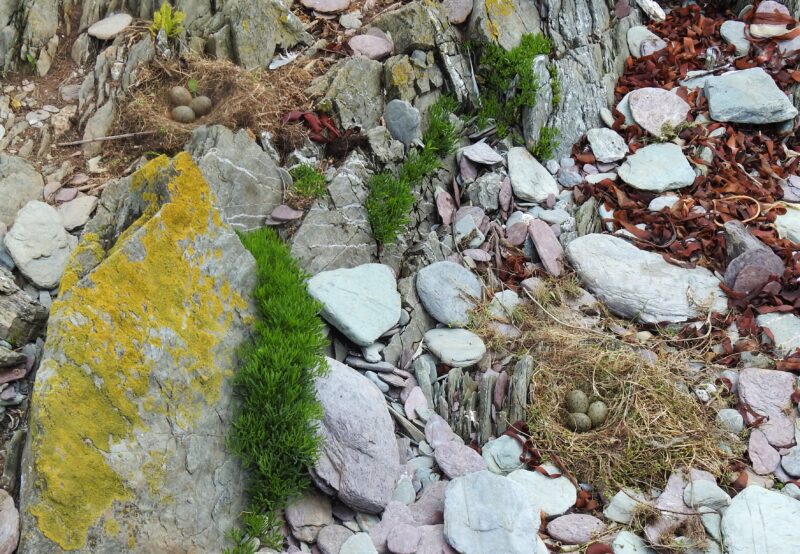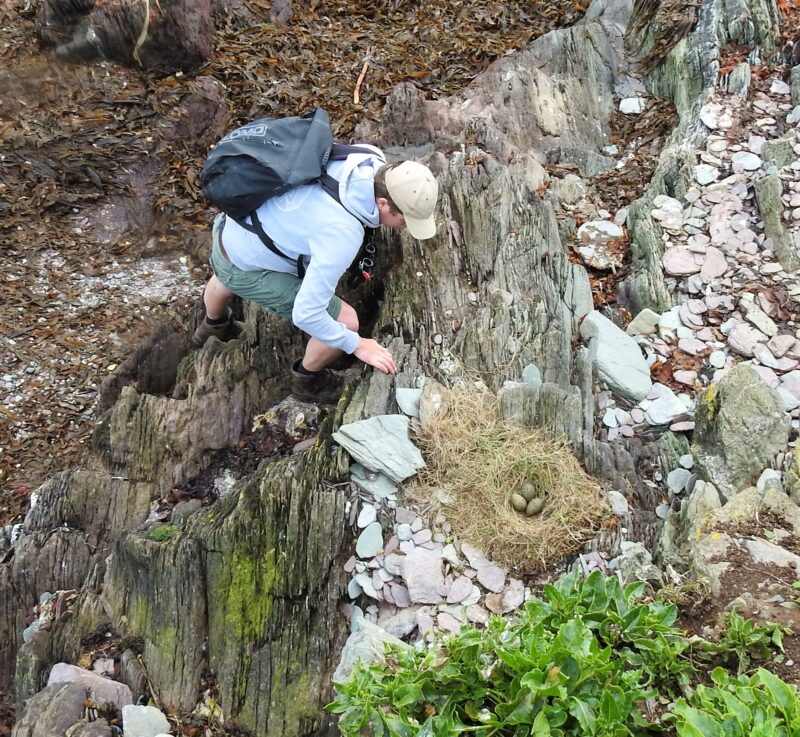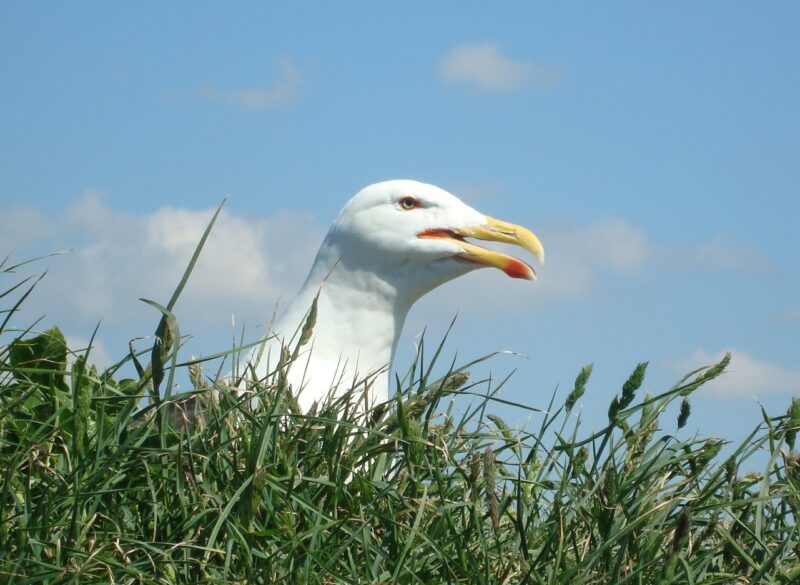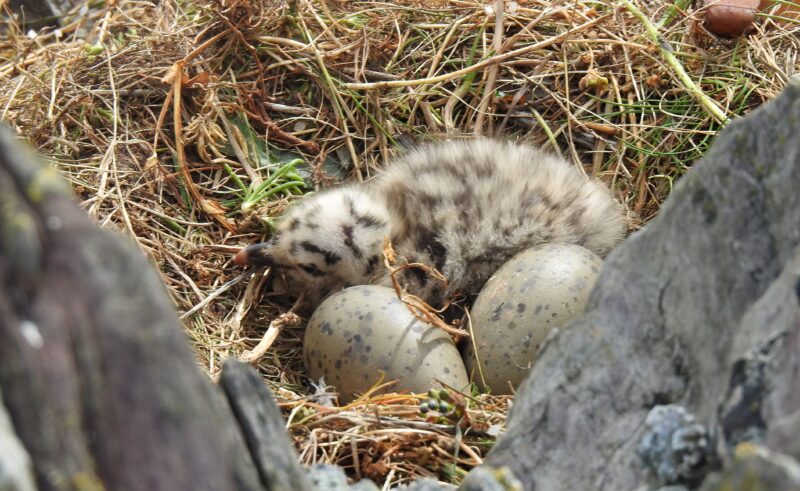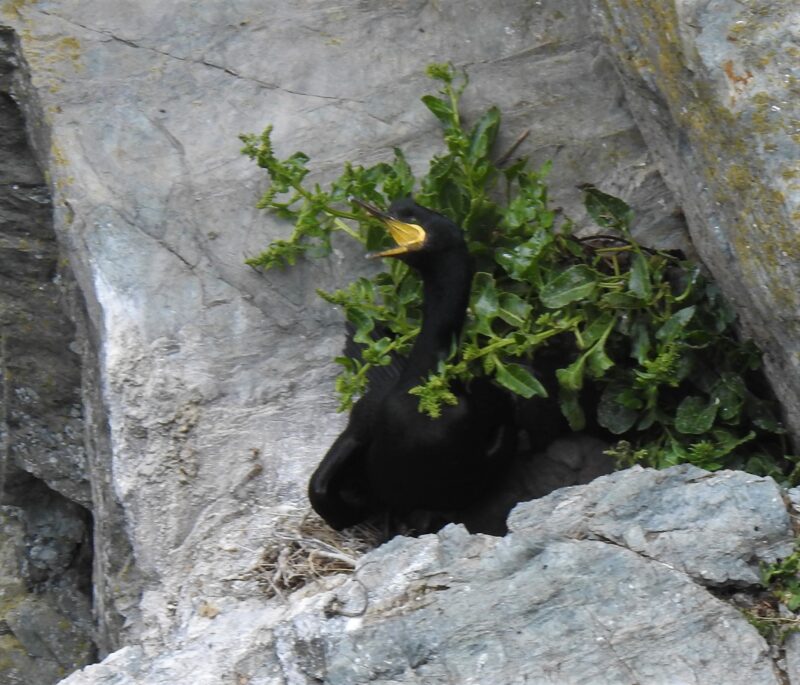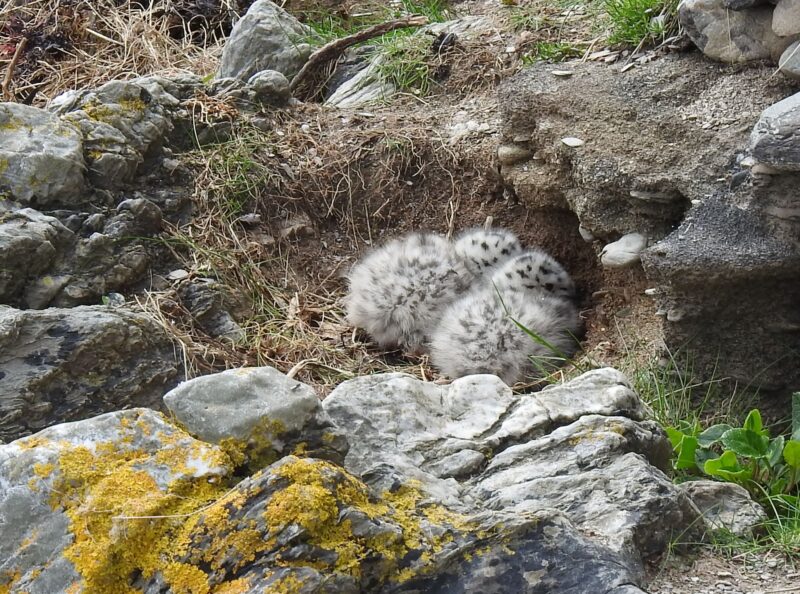The hobby of birding sometimes brings surprises. In migration seasons it is often the arrival of a rare bird – usually a bird that has landed up in the wrong place. In April I was surprised by the Hoopoe which went astray on its spring migration northwards and landed in a garden near Looe.
But in May the biggest surprise was provided one afternoon on Looe Island. With three accomplices I was counting Great Black-backed Gull nests as part of the annual island census of seabirds, and we were carefully combing the grassy slope in the south west-corner of the island for nests. My eye was caught by something in the grass – the remnants of a Puffin! Not much of the bird was left, but there was that extraordinary wedge-shaped multi-coloured bill. The red and yellow were faded, but the bill was unmistakable.
I have never seen a live Puffin in the Looe area. There are small colonies on the north Cornish coast and on Scilly, but none in South Cornwall. How did this Puffin remnant – an ex-Puffin – come to be on Looe Island? The answer is probably simple. This Puffin had been predated, and most probably by a Looe Island resident – a Great Black-backed Gull. Great Black-backs are both scavengers and predators.
Puffins spend their winters far out at sea and in spring large numbers are sometimes seen migrating along the Channel back to their breeding colonies in Wales (there is a huge colony on Skomer in Pembrokeshire) and further north. Presumably the unfortunate victim, perhaps blown close inshore by southerly winds, had encountered a Great Black-back somewhere at sea. Although fish and crustaceans are usually their major food source, these huge and powerful predatory gulls are known to prey on Puffins (and their pufflings) at their nesting burrows – the Blackback will turn the Puffin inside out before consuming it.
But they will also snatch a Puffin from the surface of the sea or even in flight. Perhaps this is what happened to the unfortunate ex-Puffin.
But let us return to the seabird count. May is the month that I particularly associate with counting birds. Many birders are inveterate listers (life lists, year lists, day lists, country lists….). I confess I am obsessive about making lists. I use the online ‘Bird Track’ to send lists of birds seen on walks to the British Trust for Ornithology, to add to their huge data base. This process includes counting the number of birds of each species seen – 5 Goldfinches, 9 House Sparrows, 22 Herring Gulls etc. But in May the counting is ramped up a gear. I count migrants arriving. I start counting nests. When I find nests I count eggs. And then chicks. And sadly, dead eggs and chicks.
Many years ago when I was living in the United States I used to watch the TV programme, Sesame Street, forerunner of the Muppets, with my young children. My favourite character in Sesame Street was the Count – ‘They call me the Count because I love to count things’. This friendly Vampire Muppet, loosely based on Count Dracula (he lived in Romania and wore a terrific cloak!), clearly suffered from ‘arithmomania’, a compulsive love of counting. I don’t remember him counting birds, but he certainly loved counting bats! It was an engaging way of teaching counting skills to young children. I seem to have been infected by the Count! I can still see his cloaked figure and hear his staccato laugh ‘Ah! Ah! Ah!’.
This May my nest counting was again focused on Looe Island, Cornwall Wildlife Trust’s beautiful nature reserve, the most important location for nesting seabirds in South-east Cornwall. At peak in May there are now more than 250 seabird nests on Looe Island. There are five species of seabirds and one shorebird that regularly nest on the island: Great Black-backed Gull, Herring Gull, Cormorant, Shag, Fulmar and Oystercatcher, occasionally joined by Lesser Black-backed Gull.
Small islands have a particular allure, heightened when accessibility is difficult or intermittent. For the birder they are often magical places, and visits linger in the memory. I can still recall a visit to the Inner Farne, off the coast of Northumberland, at the age of fourteen, and my introduction to Guillemots, Puffins and Arctic Terns. Strangely though, I had been visiting Looe for 40 years before I landed on Looe Island. It was always there on the edge of vision, but its attractions for birding were rarely advertised and strangely neglected. All that has now changed, and in the last decade I have visited Looe Island at least 200 times to study birds and seals.
Nine hectares in size, Looe Island is the largest inhabited island off the Cornwall coast and it is separated from the mainland by a narrow strip of water, less than a kilometre in width. Wilkie Collins, visiting in 1850, described it as a ‘green triangularly shaped eminence’, and it still has that appearance, with varied habitats including woodland, gardens, maritime grassland, beaches, cliffs and rocky shore. Separation is crucial in providing protection from predators and from disturbance by people and dogs. This is particularly crucial for ground-nesting seabirds and shorebirds.
In 2004 Looe Island was bequeathed to the Trust by the Atkins sisters, and management practices were introduced to preserve the Island’s unique character and to protect its wildlife. The Island was plagued by rats, a serious hazard to ground-nesting seabirds. The rats were eliminated. Hebridean sheep were introduced (recently succeeded by Shetland sheep) to maintain the quality of the maritime grassland. Human visitors were encouraged but carefully controlled. Censuses of seabirds had already begun and are important in evaluating the success of management practices, though clearly there are many other factors that influence the fortunes of nesting seabirds.
May 13th. For this year’s census there are four of us. Dave and I are the veterans and provide the experience; we have done this many times before. Liam and Drew, two young gull researchers from the University of Exeter at Penryn, add energy and agility. The survey follows a set procedure involving a complete circuit of the coast of the island, beginning at the new jetty on its eastern side. The survey is focused especially on gulls, as some of the other species have breeding seasons which do not precisely coincide. Some Cormorants have already finished nesting, while Fulmars have hardly begun. Moreover only one day is spent each year in counting gull nests because the colonies are dense and walking through them inevitably causes disturbance, and risks trampling eggs.
The circuit is divided into nine sections. The first takes us along the low cliffs on the eastern side of the island, with Herring Gull nests in profusion on the rocks below the cliff, many close together.
The rocks are slippery and precarious and there is a real risk of treading on a nest. The gulls are noisy and angry and circle above us. Herring Gulls do construct a recognizable nest, and most have three blotchy eggs lacking distinctive markings.
Tucked against the base of the cliff we find our first Oystercatcher nest, little more than a scrape. This too has three eggs, more delicately marked. The parent Oystercatchers join in the noisy chorus. We are briefly distracted by a flock of small waders on the rocks at the sea’s edge – I see Turnstones and a Dunlin, Liam spots a few Sanderling. These birds are late in departing for their northerly breeding grounds.
I clamber on to the low cliff top and come across the broken shells of much larger eggs. These were left by a pair of Canada Geese which I saw here a week ago.
This is a rather surprising location for a Canada Goose nest! There is now no sign of geese or goslings. They have made a secret, unremarked, departure.
The second section is more hazardous as it takes us across the narrow bridge on to flat-topped Little Island which projects south-eastwards from the main island.

The eastern cliffs of Looe Island from the north, Little Island is separated by a narrow channel at high tide.
This is Great Black-back territory, with their nests spaced in the sea-beet and grass. We form a line of four and walk slowly across the island and back until we are satisfied we have found all the nests. We count 30. The eggs are bigger than the Herring Gulls’, with more distinct markings, and any uncertainty about which species they belong to are dispelled by Dave’s simple measuring device.
Somewhat surprisingly we also find three Oystercatcher nests. These birds are living dangerously, in close proximity to powerful predators!
There is a poignant moment when we come across a Black-back corpse. From its ring number, L:AZ9, we can tell that it was born on Looe Island in 2013.
This is a bird that appears to have stayed in the local area for most of its life. Bruce Taggart’s records show that it has been reported 38 times, and always in the Looe area, except for one excursion to Lizard Point in 2014. It has died a few metres from the place where it was hatched. The cause of death is not clear.
The adults are agitated and swoop at us. These are big and aggressive birds, the size of a Kite or an Osprey. This is the largest gull species anywhere on the planet. An adult Black-back can weigh around two kilos and has a wingspan between 1.5 and 1.7 metres. I am glad to be wearing a hat, and carrying a stick. I well remember on a previous visit being struck forcibly on the head by an angry adult. The blow was sufficiently strong to draw blood from my scalp. Fortunately my hat was not pierced, so I avoided the unpleasant risk of infection, but it was a salutary moment.
There is one particularly aggressive bird which is stationed close to the bridge (it is there every year) and it is a relief to get back past it and on to our third section, the low cliffs facing south to the offshore rocks of the Ranneys; here we are back in well-populated Herring Gull territory. Just one nest has a chick.
I find an Oystercatcher nest just below the cliff in a shallow scrape, in exactly the same place as in previous years. Again the nest is only a few metres from several gull nests, and there is a clear risk of predation by opportunistic neighbours. My experience in previous years is that the eggs are comparatively rarely predated. But when the Oystercatcher chicks appear their survival will be a real challenge given the proximity of hungry gulls, and many broods fail to survive. The majority of chicks do not fledge.
As I look west along the cliffs at the clusters of Herring Gulls I reflect that I am seeing what is now an increasingly unusual ‘birdscape’ – gulls nesting on cliffs.
These days large numbers of gulls, and particularly Herring Gulls, nest on buildings. They have become urban and many live inland – many are ‘seagulls’ no more. More Herring Gulls nest on roofs in Looe than on the cliffs of Looe Island.
In consequence they have become regarded by some as a nuisance or even a threat, and stigmatised as ‘flying rats’. There is clearly sometimes a downside to having Herring Gulls as close neighbours, but we forget too easily that they are birds of extraordinary grace and beauty. In the sky they give us a glimpse of shining silver; the Herring Gull’s Latin name is Larus argentatus, and one attractive old name for the bird is the ‘silvermew’. They are excellent parents and protective of their young. Their proximity in towns like Looe leads us too easily to forget that they are just as much ‘wildlife’ as Puffins, Grey Seals or Peregrines, and seeing them here on the island is a reminder that cliffs were once their normal nesting habitat.
Moreover, they are in serious decline nationally, and are now Red-listed as birds of Conservation Concern. Herring Gull numbers in the UK have fallen by 48% since 1986. The decline of food sources at sea through our changing fishing practices is a main cause and has brought many of the gulls ashore to scavenge for new sources in our streets and at our dumps.
We reach the island bird hide and look across a narrow inlet into the next section for the survey. This year this has become the main nesting area for Cormorants, and these birds nest early. The cliff is thronged with young birds, some already fledged, but still reliant on adults to feed them. These nests were counted earlier in the year.
Below the hide I can see another Oystercatcher nest and Fulmars are flying along the cliffs – this is one of their favoured sites.
We move on into the next major section, the long grassy ‘Slope’ towards the south-western corner of the island, well-grazed by the Island’s flock of Shetland Sheep, but now occupied by more Great Blackbacks with carefully spaced nests – we count 36.
The birds fly up in an agitated crowd as the four of us spread out again into a line and slowly advance, counting the nests, which here are easier to see. It is here that we stumble upon the ‘ex-Puffin’.
Beyond the Slope, on the western side, the coast is more precipitous and there are coves with steep vertical cliffs. These are less attractive to gulls, but home to Cormorants, Shags and Fulmars. I note a late Cormorant nest with surprisingly young chicks, still naked and blind.
High Cove, the biggest and deepest cove, is normally the focus for nesting Cormorants but the presence of a Raven nest this year in a dominating position has deterred them. The Raven nest is empty now; a week ago I watched the last of the brood balancing precariously on a ledge just above the nest.
We count several more Shag nests, each with young chicks. The adults hiss and clack their bills and twist their necks, snake-like, when they see us.
The next sections of the survey take us along the low cliffs and beaches facing the mainland – here there are a scatter of gull nests and more Oystercatchers. On the main beach one pair has again made their nest immediately alongside the track leading up to the cottages. The tide has now dropped, enabling us to access the ninth and final section along the beach back to the jetty.
This is a favoured nesting beach for Oystercatchers and we find three nests at sites used most years. There is one Great Black-back nest and several Herring Gull nests. The final nest close to the jetty is another surprise. A Herring Gull has laid three eggs. Snugly adjacent to them is a fourth and smaller egg. It is an Oystercatcher’s! What’s going on?
Liam and Drew rig up a camera trap as part of their research project on Herring Gull feeding behaviour at the nest, so perhaps we will find out!
Our circuit is completed and my ‘arithmomania’ has been satisfied! Dave tots up the figures. We have found 104 Herring Gull nests and 85 Great Blackback nests, very healthy totals, but lower than the peaks of 126 and 91 achieved in 2019. Oystercatcher nests total a disappointing 11, considerably below the 21 achieved in 2018.
May 28th. I return to Looe Island alone and spend the day checking on the progress of the colonies and hoping to find some more Oystercatcher nests. Sure enough at a familiar site near Jetty Cottage is a new nest with, unusually, four eggs. This nest is a good example of the minimalist approach to nest-building often taken by Oystercatchers!
My total eventually reaches 20, though to my surprise five have already failed. It seems there are some active egg thieves this year. And the mystery egg in the Herring Gull nest has disappeared!
The gull nests have progressed slowly, perhaps as a result of the cold spring. There are now several Herring Gull nests with chicks, although the majority remain at the egg incubation stage. I find my first (and only) Great Blackback nest with three downy chicks – two still in the nest. Gull chicks soon become mobile.
Along the western cliffs I find some additional Shag nests ( taking my total to 10) and there are now several sites with Fulmars in occupation. I count eight, though this is no guarantee that they will all be productive – Fulmars are notorious for their lengthy courtships!
The nesting season for many species has reached a critical point. The Island is poised for an explosion of young life, and intense internecine battles for food and survival.

Looe Island’s western side at low tide. The deep gash of High Cove can be seen. Devon is in the far distance.
Derek Spooner
My thanks to Dave, Liam and Drew for their company and expertise, and to Jon and Claire, island wardens, for their support in carrying out these surveys.







